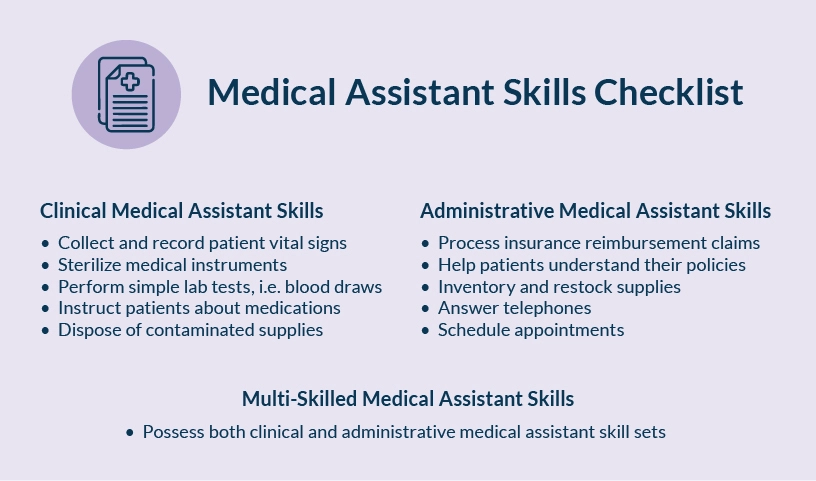Benefits of Multi-Skilled Medical Assistants in 2025

By 2028, the U.S. is expected to be 100,000 healthcare workers short of those needed to adequately handle the nation’s growing health-related needs.1 Add this to increasingly complex healthcare systems,2 an uptick in chronic diseases (especially in socioeconomically disadvantaged areas)3 and the high burden of administrative tasks4 and one thing is clear: healthcare organizations need help. What’s the solution? Multi-skilled medical assistant training is a strategy to consider.
What Is a Multi-Skilled Medical Assistant?
Some medical assistants are trained to perform clinical functions, while others are trained to assist with administrative tasks. A multi-skilled medical assistant is trained to do both. They learn medical assistant skills needed to perform both clinical and administrative duties, enabling them to provide basic patient care while assisting with front-office tasks.

Why 2025 Is the Year to Invest in Medical Assistant Skills Training
Providing your team with medical assistant training can help enhance their efficiency and skills. Providing this training in 2025 can be especially beneficial, for a number of reasons.
An Aging Population with Increased Healthcare Needs
The Bureau of Labor Statistics indicates the aging population is a major driver in an increased demand for medical assistants in upcoming years, where these healthcare professionals will be needed to assist with routine duties in doctors’ offices and other healthcare settings.5

Case in point: in 2020, 55.8 million Americans were age 65 or older.7 By 2050, this number is expected to grow to 82 million, representing a 47% increase.8 Older people have a greater risk of chronic health conditions, infectious diseases, and falls according to the Office of Disease Prevention and Health Promotion.9 This results in a need for more health services and a need for more healthcare workers in medical assistant positions.
Staffing Shortages Still a Major Concern
Medical assistant training can be an asset to healthcare organizations facing staffing shortages. When workforce resources are limited, medical assistants contribute to high-quality patient care while also enhancing team communication.10
Medical assistants can reduce the burden on healthcare providers by collecting patient health information before the visit, assisting during exams and collecting specimens for labs. They also support overloaded front-office staff by assisting with administrative tasks related to patient scheduling, billing, supply inventory and more.
Close Skills Gaps in Your Healthcare Teams
Multi-skilled medical assistant training can also help close skills gaps which exist within your organization. It can do this by providing current medical assistants the skill sets needed to perform their roles efficiently, or by serving as a cross-training strategy to create a multi-skilled team.

To conduct a skills gap analysis within your department or organization, determine the skills needed in your workforce. Next, measure current employees’ skill sets to identify whether gaps exist. Assess their current workloads and pinpoint areas where multi-skilled medical assistants could relieve pressure.
Value Across Specialties: Addressing Gaps in Key Healthcare Fields
Multi-skilled medical assistants can contribute to a strong healthcare team in numerous settings. They can assist with clinical and administrative duties in both general and specialized healthcare facilities, offering healthcare providers the opportunity to improve efficiency and better serve their patients.
A medical assistant training program which provides instruction in a wide range of vital skills can prepare these professionals to work in specialty areas, including:
- Pediatrics
- Obstetrics
- Cardiology
- Pulmonology
- Ophthalmology
- Otolaryngology
Note: Depending on state requirements, additional training and/or certification may be required for medical assistants working in specialized healthcare facilities.
Hiring vs. Reskilling Medical Assistants
To bolster your healthcare staff, you can either hire or reskill your medical assistants. Hiring new medical assistants can increase workforce size, improve diversity and provide access to individuals with new ideas. However, you also contend with the costs and time constraints of hiring and onboarding, in addition to the difficulties of finding trained talent.

Conversely, if you upskill or reskill current employees for the medical assistant role, you retain their knowledge, save hiring costs and offer team members the opportunity to advance their healthcare careers while remaining with your organization. Investing in medical assistant training in 2025 enables you to support your team member’s career goals and ambitions while, at the same time, retaining top talent.
Next Step: Multi-Skilled Medical Assistant Training
Offering employees access to medical assistant training which encompasses both clinical and administrative skills can help improve organizational efficiency, contributing to a positive patient experience. It can also close skills gaps, resulting in a stronger healthcare team.
Nasium Training offers a 25-week Medical Assistant training series which covers each skill set. Learners receive instruction in clinical areas such as vital sign collection and recording, phlebotomy procedures and minor surgical tasks. They also learn how to perform administrative tasks, such as those related to patient scheduling and health record maintenance.
Nasium Training’s high-value approach helps you identify workers who are suited for this training program, also preparing them for professional certifications. Your goals are our goals and we’re committed to helping you achieve them.
Contact us today to learn more or to discuss how we can help you strengthen your workforce and retain your top talent into 2025 and beyond.
1 Mercer. Mercer projects a deficit of over 100,000 healthcare workers in the US by 2028, worsening health disparities and impacting patient care. https://www.mercer.com/en-us/about/newsroom/future-of-the-us-healthcare-industry-labor-market-projections-by-2028/
2 Spanos S, et al. Healthcare leaders navigating complexity: a scoping review of key trends in future roles and competencies. BMC Med Educ. https://pmc.ncbi.nlm.nih.gov/articles/PMC11223336/
3 Benavidez GA, et al. Chronic Disease Prevalence in the US: Sociodemographic and geographic variations by Zip Code Tabulation Area. Centers for Disease Control and Prevention. https://www.cdc.gov/pcd/issues/2024/23_0267.htm
4 Southwick R. Administrative work takes up bulk of week for clinicians, medical office staff: Poll. Chief Healthcare Executive. https://www.chiefhealthcareexecutive.com/view/administrative-work-takes-up-bulk-of-week-for-clinicians-medical-office-staff-poll
5 Bureau of Labor Statistics. Occupational Outlook Handbook. Medical Assistants. Job Outlook. https://www.bls.gov/ooh/healthcare/medical-assistants.htm#tab-6
6 Bureau of Labor Statistics. Occupational Outlook Handbook. Medical Assistants. https://www.bls.gov/ooh/healthcare/medical-assistants.htm#tab-1
7 U.S. Census Bureau. 2020 Census: 1 in 6 people in the United States Were 65 and Over. https://www.census.gov/library/stories/2023/05/2020-census-united-states-older-population-grew.html
8 Population Reference Bureau. Fact Sheet: Aging in the United States. https://www.prb.org/resources/fact-sheet-aging-in-the-united-states/
9 Office of Disease Prevention and Health Promotion. Older Adults. https://odphp.health.gov/healthypeople/objectives-and-data/browse-objectives/older-adults
10 Fleuren BPI, et al. Love over gold and mind over matter? Identifying capabilities that preserve medical assistants’ sustainable employability. Human Res Health. https://link.springer.com/article/10.1186/s12960-024-00937-6
11 Eddy N. Survey: Healthcare struggles with persistent tech skills shortage. MobiHealthNews. https://www.mobihealthnews.com/news/survey-healthcare-struggles-persistent-tech-skills-shortage
12 Indeed for Employers. What Is the Cost of Hiring New Employees? https://www.indeed.com/hire/c/info/cost-of-hiring-employees
